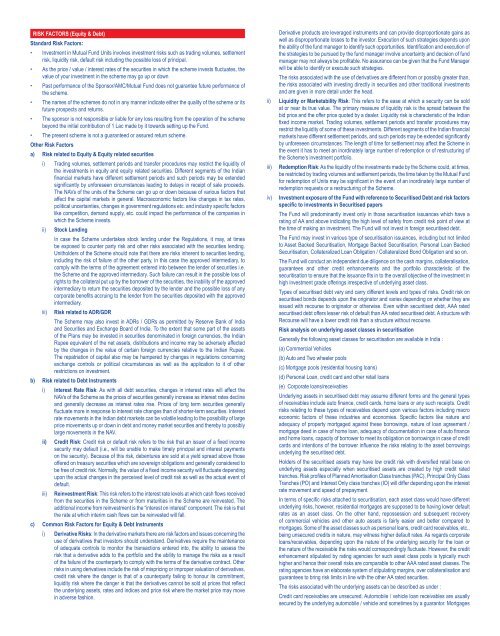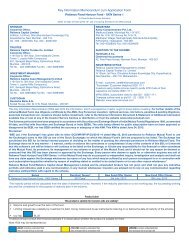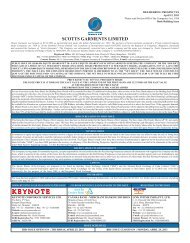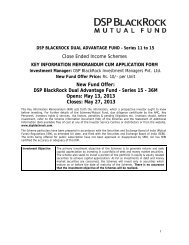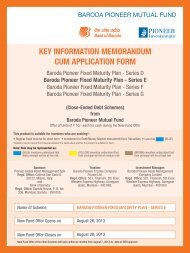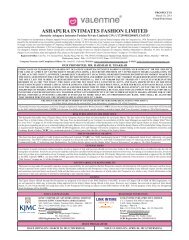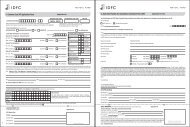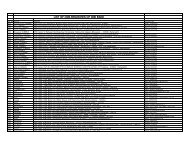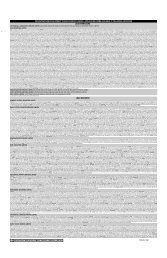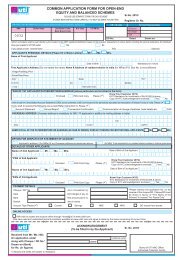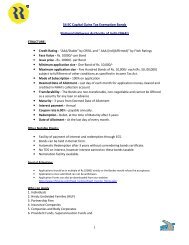RISK FACTORS (Equity & Debt)Standard Risk Factors:• Investment in Mutual Fund Units involves investment risks such as trading volumes, settlementrisk, liquidity risk, default risk including the possible loss of principal.• As the price / value / interest rates of the securities in which the scheme invests fluctuates, thevalue of your investment in the scheme may go up or down• Past performance of the Sponsor/AMC/Mutual Fund does not guarantee future performance ofthe scheme.• The names of the schemes do not in any manner indicate either the quality of the scheme or itsfuture prospects and returns.• The sponsor is not responsible or liable for any loss resulting from the operation of the schemebeyond the initial contribution of 1 Lac made by it towards setting up the Fund.• The present scheme is not a guaranteed or assured return scheme.Other Risk Factorsa) Risk related to Equity & Equity related securitiesi) Trading volumes, settlement periods and transfer procedures may restrict the liquidity ofthe investments in equity and equity related securities. Different segments of the Indianfinancial markets have different settlement periods and such periods may be extendedsignificantly by unforeseen circumstances leading to delays in receipt of sale proceeds.The NAVs of the units of the Scheme can go up or down because of various factors thataffect the capital markets in general. Macroeconomic factors like changes in tax rates,political uncertainties, changes in government regulations etc. and industry specific factorslike <strong>com</strong>petition, demand supply, etc. could impact the performance of the <strong>com</strong>panies inwhich the Scheme invests.ii)iii)Stock LendingIn case the Scheme undertakes stock lending under the Regulations, it may, at timesbe exposed to counter party risk and other risks associated with the securities lending.Unitholders of the Scheme should note that there are risks inherent to securities lending,including the risk of failure of the other party, in this case the approved intermediary, to<strong>com</strong>ply with the terms of the agreement entered into between the lender of securities i.e.the Scheme and the approved intermediary. Such failure can result in the possible loss ofrights to the collateral put up by the borrower of the securities, the inability of the approvedintermediary to return the securities deposited by the lender and the possible loss of anycorporate benefits accruing to the lender from the securities deposited with the approvedintermediary.Risk related to ADR/GDRThe Scheme may also invest in ADRs / GDRs as permitted by Reserve Bank of Indiaand Securities and Exchange Board of India. To the extent that some part of the assetsof the Plans may be invested in securities denominated in foreign currencies, the IndianRupee equivalent of the net assets, distributions and in<strong>com</strong>e may be adversely affectedby the changes in the value of certain foreign currencies relative to the Indian Rupee.The repatriation of capital also may be hampered by changes in regulations concerningexchange controls or political circumstances as well as the application to it of otherrestrictions on investment.b) Risk related to Debt Instrumentsi) Interest Rate Risk: As with all debt securities, changes in interest rates will affect theNAVs of the Scheme as the prices of securities generally increase as interest rates declineand generally decrease as interest rates rise. Prices of long term securities generallyfluctuate more in response to interest rate changes than of shorter-term securities. Interestrate movements in the Indian debt markets can be volatile leading to the possibility of largeprice movements up or down in debt and money market securities and thereby to possiblylarge movements in the NAV.ii)iii)Credit Risk: Credit risk or default risk refers to the risk that an issuer of a fixed in<strong>com</strong>esecurity may default (i.e., will be unable to make timely principal and interest paymentson the security). Because of this risk, debentures are sold at a yield spread above thoseoffered on treasury securities which are sovereign obligations and generally considered tobe free of credit risk. Normally, the value of a fixed in<strong>com</strong>e security will fluctuate dependingupon the actual changes in the perceived level of credit risk as well as the actual event ofdefault.Reinvestment Risk: This risk refers to the interest rate levels at which cash flows receivedfrom the securities in the Scheme or from maturities in the Scheme are reinvested. Theadditional in<strong>com</strong>e from reinvestment is the “interest on interest” <strong>com</strong>ponent. The risk is thatthe rate at which interim cash flows can be reinvested will fall.c) Common Risk Factors for Equity & Debt Instrumentsi) Derivative Risks: In the derivative markets there are risk factors and issues concerning theuse of derivatives that investors should understand. Derivatives require the maintenanceof adequate controls to monitor the transactions entered into, the ability to assess therisk that a derivative adds to the portfolio and the ability to manage the risks as a resultof the failure of the counterparty to <strong>com</strong>ply with the terms of the derivative contract. Otherrisks in using derivatives include the risk of mispricing or improper valuation of derivatives,credit risk where the danger is that of a counterparty failing to honour its <strong>com</strong>mitment,liquidity risk where the danger is that the derivatives cannot be sold at prices that reflectthe underlying assets, rates and indices and price risk where the market price may movein adverse fashion.ii)iii)iv)Derivative products are leveraged instruments and can provide disproportionate gains aswell as disproportionate losses to the investor. Execution of such strategies depends uponthe ability of the fund manager to identify such opportunities. Identification and execution ofthe strategies to be pursued by the fund manager involve uncertainty and decision of fundmanager may not always be profitable. No assurance can be given that the Fund Managerwill be able to identify or execute such strategies.The risks associated with the use of derivatives are different from or possibly greater than,the risks associated with investing directly in securities and other traditional investmentsand are given in more detail under the head.Liquidity or Marketability Risk: This refers to the ease at which a security can be soldat or near its true value. The primary measure of liquidity risk is the spread between thebid price and the offer price quoted by a dealer. Liquidity risk is characteristic of the Indianfixed in<strong>com</strong>e market. Trading volumes, settlement periods and transfer procedures mayrestrict the liquidity of some of these investments. Different segments of the Indian financialmarkets have different settlement periods, and such periods may be extended significantlyby unforeseen circumstances. The length of time for settlement may affect the Scheme inthe event it has to meet an inordinately large number of redemption or of restructuring ofthe Scheme’s investment portfolio.Redemption Risk: As the liquidity of the investments made by the Scheme could, at times,be restricted by trading volumes and settlement periods, the time taken by the Mutual Fundfor redemption of Units may be significant in the event of an inordinately large number ofredemption requests or a restructuring of the Scheme.Investment exposure of the Fund with reference to Securitised Debt and risk factorsspecific to investments in Securitised papersThe Fund will predominantly invest only in those securitisation issuances which have arating of AA and above indicating the high level of safety from credit risk point of view atthe time of making an investment. The Fund will not invest in foreign securitised debt.The Fund may invest in various type of securitisation issuances, including but not limitedto Asset Backed Securitisation, Mortgage Backed Securitisation, Personal Loan BackedSecuritisation, Collateralized Loan Obligation / Collateralized Bond Obligation and so on.The Fund will conduct an independent due diligence on the cash margins, collateralisation,guarantees and other credit enhancements and the portfolio characteristic of thesecuritisation to ensure that the issuance fits in to the overall objective of the investment inhigh investment grade offerings irrespective of underlying asset class.Types of securitised debt vary and carry different levels and types of risks. Credit risk onsecuritised bonds depends upon the originator and varies depending on whether they areissued with recourse to originator or otherwise. Even within securitised debt, AAA ratedsecuritised debt offers lesser risk of default than AA rated securitised debt. A structure withRecourse will have a lower credit risk than a structure without recourse.Risk analysis on underlying asset classes in securitisationGenerally the following asset classes for securitisation are available in India :(a) Commercial Vehicles(b) Auto and Two wheeler pools(c) Mortgage pools (residential housing loans)(d) Personal Loan, credit card and other retail loans(e) Corporate loans/receivablesUnderlying assets in securitised debt may assume different forms and the general typesof receivables include auto finance, credit cards, home loans or any such receipts. Creditrisks relating to these types of receivables depend upon various factors including macroeconomic factors of these industries and economies. Specific factors like nature andadequacy of property mortgaged against these borrowings, nature of loan agreement /mortgage deed in case of home loan, adequacy of documentation in case of auto financeand home loans, capacity of borrower to meet its obligation on borrowings in case of creditcards and intentions of the borrower influence the risks relating to the asset borrowingsunderlying the securitised debt.Holders of the securitised assets may have low credit risk with diversified retail base onunderlying assets especially when securitised assets are created by high credit ratedtranches. Risk profiles of Planned Amortisation Class tranches (PAC), Principal Only ClassTranches (PO) and Interest Only class tranches (IO) will differ depending upon the interestrate movement and speed of prepayment.In terms of specific risks attached to securitisation, each asset class would have differentunderlying risks, however, residential mortgages are supposed to be having lower defaultrates as an asset class. On the other hand, repossession and subsequent recoveryof <strong>com</strong>mercial vehicles and other auto assets is fairly easier and better <strong>com</strong>pared tomortgages. Some of the asset classes such as personal loans, credit card receivables, etc.,being unsecured credits in nature, may witness higher default rates. As regards corporateloans/receivables, depending upon the nature of the underlying security for the loan orthe nature of the receivable the risks would correspondingly fluctuate. However, the creditenhancement stipulated by rating agencies for such asset class pools is typically muchhigher and hence their overall risks are <strong>com</strong>parable to other AAA rated asset classes. Therating agencies have an elaborate system of stipulating margins, over collateralisation andguarantees to bring risk limits in line with the other AA rated securities.The risks associated with the underlying assets can be described as under :Credit card receivables are unsecured. Automobile / vehicle loan receivables are usuallysecured by the underlying automobile / vehicle and sometimes by a guarantor. Mortgages
are secured by the underlying property. Personal loans are usually unsecured.Corporate loans could be unsecured or secured by a charge on fixed assets / receivablesof the <strong>com</strong>pany or a letter of <strong>com</strong>fort from the parent <strong>com</strong>pany or a guarantee from a bank/ financial institution. As a rule of thumb, underlying assets which are secured by a physicalasset / guarantor are perceived to be less risky than those which are unsecured. By virtueof this, the risk and therefore the yield in descending order of magnitude would be creditcard receivables, personal loans, vehicle /automobile loans, mortgages and corporateloans assuming the same rating.Some of the factors, which are typically analyzed for any pool are as follows :Size of the loan : generally indicates the kind of assets financed with loans. Also indicates whetherthere is excessive reliance on very small ticket size, which may result in difficult and costly recoveries.To illustrate, the ticket size of housing loans is generally higher than that of personal loans. Hence inthe construction of a housing loan asset pool for say Rs. 10,000,000/- it may be easier to constructa pool with just 10 housing loans of Rs. 1,000,000 each rather than to construct a pool of personalloans as the ticket size of personal loans may rarely exceed Rs. 500,000/- per individual. Also totake this illustration further, if one were to construct a pool of Rs. 10,000,000/- consisting of personalloans of Rs. 100,000/- each, the larger number of contracts (100 as against one of 10 housing loansof Rs. 10 lakh each) automatically diversifies the risk profile of the pool as <strong>com</strong>pared to a housingloan based asset pool.Average original maturity of the pool : indicates the original repayment period and whether theloan tenors are in line with industry averages and borrower’s repayment capacity. To illustrate, in a carpool consisting of 60-month contracts, the original maturity and the residual maturity of the pool viz.number of remaining installments to be paid gives a better idea of the risk of default of the pool itself.If in a pool of 100 car loans having original maturity of 60 months, if more than 70% of the contractshave paid more than 50% of the installments and if no default has been observed in such contracts,this is a far superior portfolio than a similar car loan pool where 80% of the contracts have not evencrossed 5 installments.Loan to Value (“LTV”) Ratio : Indicates how much % value of the asset is financed by borrower’sown equity. The lower the LTV ratio, the better it is. This ratio stems from the principle that where theborrower’s own contribution of the asset cost is high, the chances of default are lower. To illustrate fora vehicle costing Rs. 50 lakhs, if the borrower has himself contributed Rs. 40 lakhs and has taken onlyRs. 10 lakhs as a loan, he is going to have lesser propensity to default as he would lose an asset worthRs. 50 lakhs if he defaults in repaying an installment. This is as against a borrower who may meet onlyRs. 5 lakhs out of his own equity for a vehicle costing Rs. 50 lakhs. Between the two scenarios givenabove, the latter would have higher risk of default than the former.Average seasoning of the pool : Indicates whether borrowers have already displayed repaymentdiscipline. To illustrate, in the case of a personal loan, if a pool of assets consists of those who havealready repaid 80% of the installments without default, this certainly is a superior asset pool than theone where only 10% of the installments have been paid. In the former case, the portfolio has alreadydemonstrated that the repayment discipline is far higher.Default rate distribution : Indicates how much % of the pool and overall portfolio of the originator iscurrent, how much is in 0-30 DPD (days past due), 30-60 DPD, 60-90 DPD and so on. The rationalehere is very obvious - as against 0-30 DPD, the 60-90 DPD is certainly a higher risk category.Unlike in plain vanilla instruments, in securitisation transactions, it is possible to work towards a targetcredit rating, which could be much higher than the originator’s own credit rating. This is possiblethrough a mechanism called “Credit enhancement” and is fulfilled by filtering the underlying assetclasses and applying selection criteria, which further diminishes the risk inherent for a particular assetclass. The purpose of credit enhancement is to ensure timely payment to the investors, if the actualcollections from the pool of receivables for a given period are short of the contractual payouts onsecuritisation. Securitisation is normally a non-recourse instrument and therefore, the repayment onsecuritisation would have to <strong>com</strong>e from the underlying assets and the credit enhancement. Therefore,the rating criteria centrally focuses on the quality of the underlying assets.World over, the quality of credit ratings is measured by default rates and stability. An analysis of ratingtransition and default rates, witnessed in both international and domestic arena, clearly reveals thatstructured finance ratings have been characterized by far lower default and transition rates than thatof plain vanilla debt ratings. Further, internationally, in case of structured finance ratings, not only arethe default rates low but post default recovery is also high.In the Indian scenario, also, more than 95% of issuances have been AAA rated issuances indicatingthe strength of the underlying assets as well as adequacy of credit enhancement.Interest Rate RiskThe change in market interest rates – prepayments may not change the absolute amount ofreceivables for the investors, but may have an impact on the re-investment of the periodic cash flowsthat the investor receives in the securitised paper.Limited liquidity & price riskPresently, secondary market for securitised papers is not very liquid. There is no assurance that adeep secondary market will develop for such securities. This could limit the ability of the investor toresell them. Even if a secondary market develops and sales were to take place, these secondarytransactions may be at a discount to the initial issue price due to changes in the interest ratestructure.Limited recourse, delinquency and credit riskSecuritised transactions are normally backed by pool of receivables and credit enhancement asstipulated by the rating agency, which differ from issue to issue. The credit enhancement stipulatedrepresents a limited loss cover to the Investors. These certificates represent an undivided beneficialinterest in the underlying receivables and there is no obligation of either the Issuer or the Seller orthe originator, or the parent or any affiliate of the seller, issuer and originator. No financial recourseis available to the certificate holders against the investors’ representative. Delinquencies and creditlosses may cause depletion of the amount available under the credit enhancement and thereby theinvestor payouts may get affected if the amount available in the credit enhancement facility is notenough to cover the shortfall. On persistent default of an obligor to repay his obligation, the servicermay repossess and sell the underlying asset. However many factors may affect, delay or prevent therepossession of such asset or the length of time required to realize the sale proceeds on such sales.In addition, the price at which such asset may be sold may be lower than the amount due from thatobligor.Risks due to possible prepayments: Weighted Tenor / YieldAsset securitisation is a process whereby <strong>com</strong>mercial or consumer credits are packaged and sold inthe form of financial instruments. Full prepayment of underlying loan contract may arise under any ofthe following circumstances :• Obligor pays the receivable due from him at any time prior to the scheduled maturity date of thatreceivable; or• Receivable is required to be repurchased by the seller consequent to its inability to rectify amaterial misrepresentation with respect to that receivable; or• The servicer recognizing a contract as a defaulted contract and hence repossessing theunderlying asset and selling the same; or• In the event of prepayments, investors may be exposed to changes in tenor and yield.Bankruptcy of the originator or sellerIf originator be<strong>com</strong>es subject to bankruptcy proceedings and the court in the bankruptcy proceedingsconcludes that the sale from originator to Trust was not a sale then an investor could experiencelosses or delays in the payments due. All possible care is generally taken in structuring the transactionso as to minimize the risk of the sale to Trust not being construed as a “True Sale”. Legal opinionis normally obtained to the effect that the assignment of Receivables to Trust in trust for and for thebenefit of the Investors, as envisaged herein, would constitute a true sale.Bankruptcy of the investor’s agentIf an investor’s agent be<strong>com</strong>es subject to bankruptcy proceedings and the court in the bankruptcyproceedings concludes that the recourse of investor’s agent to the assets/receivables is not in itscapacity as agent/Trustee but in its personal capacity, then an investor could experience lossesor delays in the payments due under the swap agreement. All possible care is normally taken instructuring the transaction and drafting the underlying documents so as to provide that the assets/receivables if and when held by investor’s agent is held as agent and in Trust for the investors andshall not form part of the personal assets of investor’s agent. Legal opinion is normally obtained to theeffect that the investor’s agent’s recourse to assets/receivables is restricted in its capacity as agentand Trustee and not in its personal capacity.Credit Rating of the Transaction / CertificateThe credit rating is not a re<strong>com</strong>mendation to purchase, hold or sell the certificate in as much as theratings do not <strong>com</strong>ment on the market price of the certificate or its suitability to a particular investor.There is no assurance by the rating agency either that the rating will remain at the same level for anygiven period of time or that the rating will not be lowered or withdrawn entirely by the rating agency.Risk of Co-minglingThe servicers normally deposit all payments received from the obligors into the collection account.However, there could be a time gap between collection by a servicer and depositing the same into thecollection account especially considering that some of the collections may be in the form of cash. Inthis interim period, collections from the Loan Agreements may not be segregated from other funds ofthe servicer. If the servicer fails to remit such funds due to investors, the investors may be exposedto a potential loss.Risk factors associated with processing of transaction through Stock Exchange Mechanism:The trading mechanism introduced by the stock exchange(s) is configured to accept and processtransactions for mutual fund units in both Physical and Demat <strong>Form</strong>. The allotment and/or redemptionof Units through NSE and/or BSE, on any Business Day will depend upon the modalities of processingviz. collection of application form, KYC documentation, order processing/ settlement, etc. upon whichthe Fund has no control. Moreover, transactions conducted through the stock exchange mechanismshall be governed by the operating guidelines and directives issued by respective recognized stockexchange(s).v) Risks associated with Short Selling and Securities Lending -The risks in lending portfolio securities, as with other extensions of credit, consist of the failureof another party, in this case the approved intermediary, to <strong>com</strong>ply with the terms of agreemententered into between the lender of securities i.e. the Scheme and the approved intermediary.Such failure to <strong>com</strong>ply can result in the possible loss of rights in the collateral put up by theborrower of the securities, the inability of the approved intermediary to return the securitiesdeposited by the lender and the possible loss of any corporate benefits accruing to the lenderfrom the securities deposited with the approved intermediary.Scheme Specific Risk Factors (Equity)l) Risk specific to Sector Scheme (JM Basic Fund)A Unitholder in JM Basic Fund should note that these Schemes are designed as Sectoral Schemewith the aim to invest only in the Sector specified in the Scheme Information Documents and assuch the performance of the sector would have a direct bearing on the performance of SchemeUnitholders should also note that there might be concentration of investments in <strong>com</strong>paniesof the basic industries thereby carrying the risk of non-diversification. Therefore, the NAV ofthis Scheme would be dependent upon the performance and market price movement of such<strong>com</strong>panies in the sector. Hence the movement in the NAV of this Scheme will be more volatile<strong>com</strong>pared to the NAV of a scheme with more diversified portfolio.The performance of JM Basic Fund is being benchmarked against BSE 200.


